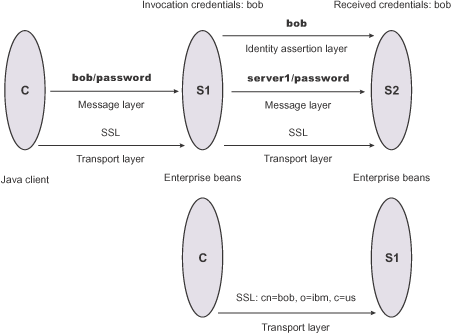Scenario 2: Basic authentication, identity assertion, and client certificates
This scenario is the same as Scenario 1, except for the interaction from client C2 to server S2. Therefore, the configuration of Scenario 1 still is valid, but you have to modify server S2 slightly and add a configuration for client C2. The configuration is not modified for C1 or S1.

Configure client C2
Client C2 requires transport layer authentication (SSL client certificates). To configure transport layer authentication:- Point the client to the sas.client.props file.
Use the com.ibm.CORBA.ConfigURL=file:/C:/was/properties/sas.client.props property. All further configuration involves setting properties within this file.
- Enable SSL.In this case, SSL is supported but not required:
com.ibm.CSI.performTransportAssocSSLTLSSupported=true,
com.ibm.CSI.performTransportAssocSSLTLSRequired=false - Disable client authentication at the message layer.
com.ibm.CSI.performClientAuthenticationRequired=false,
com.ibm.CSI.performClientAuthenticationSupported=false - Enable client authentication at the transport layer where it is supported, but not required:
com.ibm.CSI.performTLClientAuthenticationRequired=false,
com.ibm.CSI.performTLClientAuthenticationSupported=true
Configure server, S2
In the console, server S2 is configured for incoming requests to SSL client authentication and identity assertion. Configuration for outgoing requests is not relevant for this scenario.- Enable identity assertion.
- Disable user ID and password authentication.
- Enable SSL.
- Enable SSL client authentication.
You can mix and match these configuration options. However, a precedence exists as to which authentication features become the identity in the received credential:
- Identity assertion
- Message-layer client authentication (basic authentication or token)
- Transport-layer client authentication (SSL certificates)
Related tasks
Configure IIOP authentication
Related Reference
Scenario 1: Basic authentication and identity assertion
Scenario 3: Client certificate authentication and RunAs system
Scenario 4: TCP/IP transport using a virtual private network
Example: Common Secure Interoperability V2 scenarios